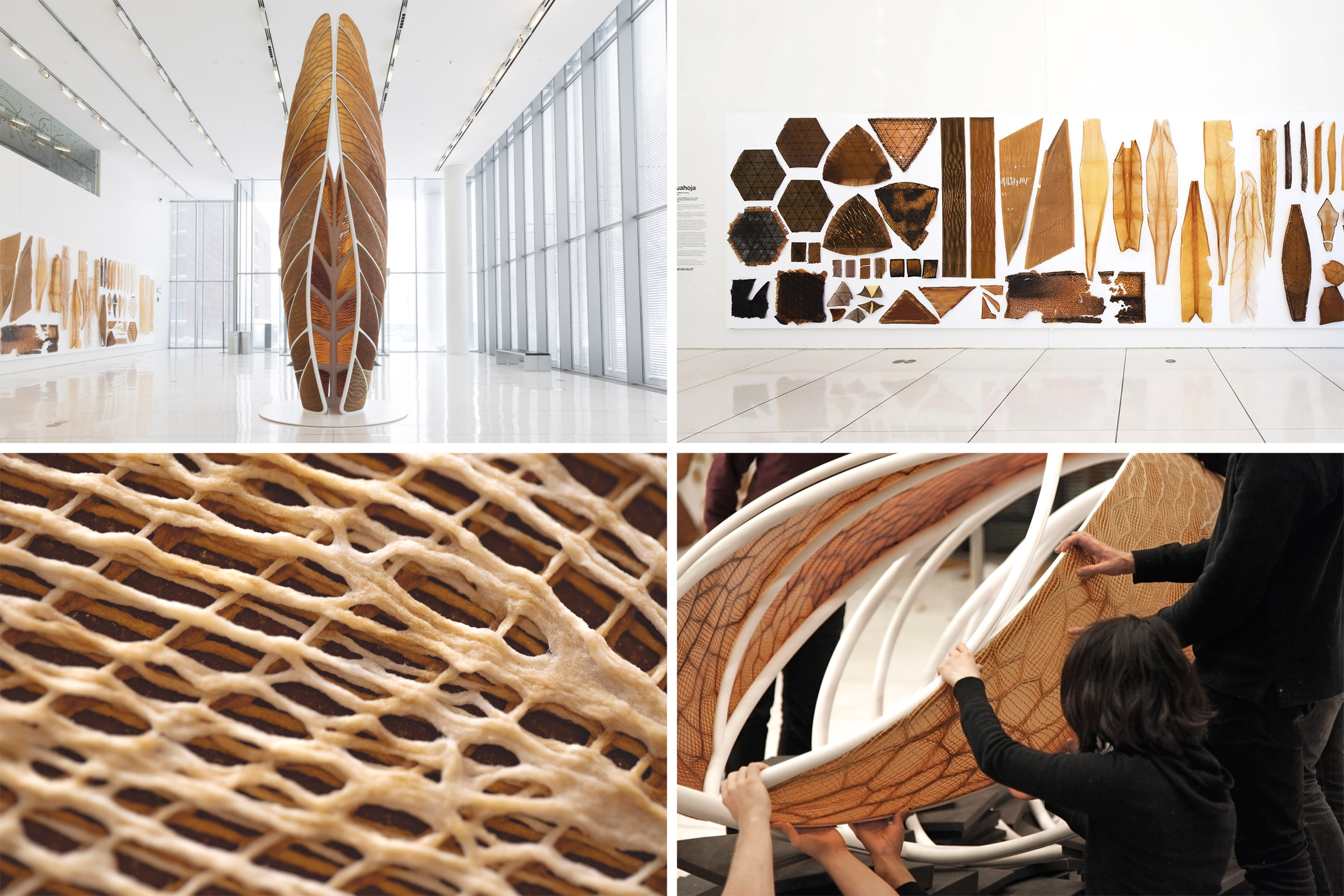
Aguahoja III is a pavilion robotically manufactured from organic matter that was created by American-Israeli architect and designer Neri Oxman with The Mediated Matter Group.
The structure is being introduced by Oxman today as part of her Dezeen 15 guest editorship, for which she will also join Dezeen’s editor-in-chief Marcus Fairs in a live interview at 4:00pm London time.
Aguahoja III is one of three biopolymer pavilions made by Oxman with The Mediated Matter Group to examine how materials that are considered as waste can inform design.
Each structure is made from abundant molecular components found in tree branches, insect exoskeletons and human bones.
From Water to Water
Aguahoja III by Neri Oxman and The Mediated Matter Group
In the natural world, water shapes the development of matter, guiding the assembly of molecules into complex structural hierarchies and material compositions. In human-made designs, we attempt to achieve this level of complexity by arranging discrete, homogeneous parts into assemblies made functional by defining geometries in isolation from material composition. Yet, single-material biological systems are known to adapt their chemical compositions to accommodate a variety of structural and environmental requirements, generating variable-property gradients across the surface area and volume of the structure. By drawing upon dynamic, water-based biopolymer materials and incorporating material parameters into instructions for fabrication processes, we can begin to redesign our built structures as if they were grown, with the functional and ecological sophistication of Nature.
Aguahoja is a collection of structures digitally designed and robotically manufactured from some of the most abundant biopolymers on our planet: cellulose, which is found in the cell walls of plants; chitosan, refined from chitin found in crustacean exoskeletons; and pectin, which is found in the skin of ripe fruits such as apples.
Aguahoja thus embodies the material ecology design approach to material formation and decay by design
The diversity of forms and behaviors embodied in Aguahoja’s structures mirrors the manner in which–from a minimal palette of molecular components–Nature constructs an extensive array of multifunctional materials with no synthetic parallels. A material such as chitin manifests in the strong, hard exoskeletons of crustaceans such as shrimp and lobster, as well as in the extremely thin, transparent membranes of dragonfly wings and the soft tissue of fungi. In contrast to steel and concrete, the biocomposites formed by organic materials are in constant dialogue with their ecological niches, capable of dynamically adapting to changing environmental conditions.
Chitin is the second-most abundant biopolymer after cellulose and is widely refined in bulk from abundant waste streams generated by the shellfish industry. In this way, biopolymers and the living systems they comprise outperform human engineering not only through their efficiency and diversity of functions, but also through their renewability. Through Aguahoja, we propose a way to temporarily divert these organic materials from natural resource cycles, augment them with precise physical properties, and shape them into functional designs before enabling their controlled decay. Blended in various ratios, they form the building blocks for 3D printable bio-cements with tunable material properties that perform predictably at multiple scales and can be made to decay or persist over time.

Each unique material composition imparts specific properties such as stiffness, strength, and color. In contrast to most synthetic materials, the pieces that comprise Aguahoja react to their environment over their lifespan, adapting their shape and color in response to natural fluctuations in heat, humidity, airflow, and sunlight. Upon exposure to rainwater, they degrade programmatically, returning their constituents back to the environment. These material and environmental properties are simulated in advance of fabrication to directly inform design of material composition and structural form from the very beginning. Aguahoja thus embodies the Material Ecology design approach to material formation and decay by design.
We looked to one of Nature’s most successful architectural structures, the tree
Standing five meters tall, the Aguahoja I pavilion is composed of a tunable biocomposite skin and a polymeric scaffold. To guide its design, we looked to one of Nature’s most successful architectural structures, the tree. Much like a leaf, the pavilion combines skin-like and shell-like structural typologies. At the largest scale, the shell-like scaffold takes the form of a truncated ovaloid skeleton with a rigid vertical spine that supports a series of slender ribs, branching and arcing diagonally toward a front aperture. Cradled in the spaces of the skeleton are 32 individual biocomposite skin-and-shell panels with different degrees of stiffness, flexibility, and opacity, together forming a continuous façade or ‘structural skin’ modeled after human skin, with regions that serve as structure, window, and environmental filter. Every cell of our tree grew out of a negotiation between interrelated structural self-load, extrinsic environmental, and intrinsic hydration constraints, exploring the question: can we design, not destroy trees?

Building upon its predecessor, the Aguahoja II pavilion proposes a future in which the built environment can further communicate and cooperate with living ecologies. It places an emphasis on a structure’s interactions with non-human organisms, at all stages of synthesis, life, and death. Natural pigments and dyes found in beetroot, turmeric, butterfly pea flower, and squid ink are distributed through the flexible skin to create gradients of color that emulate those used as signaling mechanisms by specific organisms. Dark veins of rigid cellulose reinforce the structure through a procedurally generated pattern embedded in the skin. These optical and mechanical patterns suggest a means by which architecture might dynamically communicate with an ecology, attracting, repelling, or otherwise mediating the behaviors of other organisms toward the empowerment of the ecosystem.
The Aguahoja II pavilion proposes a future in which the built environment can further communicate and cooperate with living ecologies
In our upcoming monograph show at SFMOMA (February 2022), we will expose the Aguahoja I pavilion to the elements for the first time ever, measuring the transference of calories as it decomposes. Set outdoors in a rooftop garden, the pavilion will be accompanied by a suite of instruments designed to visualize the measurement of its ‘rate of decay’ in the context of its exposure to the elements. The instruments express environmental data (in addition to algorithmically synthesized information) through light and include: an on-site weather station, weather gauges, and a bespoke caloric clock. Specifically, four gauges will be installed within the gallery, in close proximity to the installation, displaying real-time weather data such as wind, humidity, temperature, and precipitation. Their compounded impact will affect and inform the structural decomposition and degradation of the pavilion over space (i.e., shape deformation) and over time (i.e., rate of decay).

The caloric clock – a device designed to track the number of calories the pavilion ‘burns’ during its degradation and decay –displays continuously updated caloric values representing the calculated total amount of calories remaining within Aguahoja I’s structure. Based on its biopolymeric material composition (see related technical publications), the initial caloric footprint of the pavilion’s overall structure is estimated at 40,000 calories. The combined impact of wind, humidity, temperature, and precipitation on the pavilion’s material composition and its rate of decay are calculated as a function of individually weighted and experimentally informed impact factors. These impact factors are used in conjunction with the real-time weather data to subtract a daily caloric toll on the biocomposite pieces, indicating how much energy has been transferred to the direct natural environment (ie the garden) surrounding the built structure (ie, the pavilion).
The Aguahoja III pavilion –Aguahoja I’s ‘sister pavilion’ situated within the gallery – is accompanied by a similar clock, indicating the pavilion’s residual caloric content assuming a pristine, weather-controlled environment (ie, the gallery). These measurements serve as a control for those obtained from observing Aguahoja I, characterizing the ecological micro-niche it resides in.
Matter and stored energy embodied in the Aguahoja I pavilion will gradually give way to ecological forces, assisting in the natural process of decay and biodegradation as well as the fueling of new growth. Energy will transform into biomass anew, nourishing plant growth and thereby augmenting the garden’s ecological niche.
Our hope is that visitors will be able to witness this unique experiment in real time, rain or shine, and gain an understanding of the complex yet empowering set of tools, techniques, and technologies utilized to build architectural scale structures made almost entirely of bio-based materials. We hope, too, to cultivate an appreciation for the cycle of decay, expressing how the loss of built matter is recovered through and in the environment, contributing to a bona fide Material Ecology: a tree becomes a building, a building becomes a tree.
Water-based digital fabrication
Motivated by the question of how to enable the use of renewable and biocompatible materials for the design and manufacturing of meter-scale, geometrically complex, and materially heterogeneous structures–ultimately demonstrated by the three architectural pavilions of Aguahoja – we developed an additive manufacturing platform and workflow entitled water-based digital fabrication. With it, designers can tune variations in material chemistry to achieve functional material performance. Our approach leverages molecular self-assembly and hydration-guided shape formation to induce large-scale anisotropic self-folding behaviors in 3D printed biocomposite structures. By using resources that are abundant in Nature and can readily be decomposed, the Aguahoja collection embeds design and construction within natural material cycles, applying materials produced by, consumed by, and ultimately, used to enhance the material production of biodiverse ecosystems–from dust to dust; from water to water.
The imagery is courtesy of Neri Oxman and The Mediated Matter Group. The main image is an interior view of Aguahoja I.
Project credits:
Aguahoja I: Jorge Duro-Royo, Laia Mogas-Soldevilla, Joshua Van Zak, Yen-Ju (Tim) Tai, Andrea Ling, Nic Lee, Barrak Darweesh, Daniel Lizardo, Christoph Bader, João Costa, Sunanda Sharma, James Weaver, and Prof. Neri Oxman.
Aguahoja II: Nic Lee, Joshua Van Zak, Ramon Elias Weber, Joseph Henry Kennedy, Jorge Duro-Royo, Christoph Bader, João Costa, Sunanda Sharma, James Weaver, and Prof. Neri Oxman.
Aguahoja III: Nic Lee, João Costa, Felix Kraemer, Nitzan Zilberman, Anran Li, Kelly Egorova, and Prof. Neri Oxman.
Research collaborators: Joseph Faraguna, Matthew Bradford, Loewen Cavill, Emily Ryeom, Aury Hay, Yi Gong, Brian Huang, Danielle Grey-Stewart, Amelia Wong, Ava Iranmanesh, Hannah Gazdus, Tzu-Chieh Tang, Shaymus Hudson, Prof. Pam Silver, Prof. Tim Lu; Substructure Production: Stratasys Ltd., Stratasys Direct Manufacturing; Music Composition: Jeremy Flower; Video Production: The Mediated Matter Group, Paula Aguilera, Jonathan Williams; Acknowledgments: MIT Media Lab, NOE LLC, Stratasys Ltd., Habitat Horticulture, MIT Research Laboratory of Electronics, Wyss Institute at Harvard, Department of Systems Biology at Harvard, GETTYLAB, Robert Wood Johnson Foundation, Autodesk BUILD Space, TBA-21 Academy, Thyssen-Bornemisza Art Contemporary, Stratasys Direct Manufacturing, National Academy of Sciences, San Francisco Museum of Modern Art, Esquel Group.
Technical publications:
Lee, N. A., Weber, R. E., Kennedy, J. H., Van Zak, J. J., Smith, M., Duro-Royo, J., & Oxman, N. (2020). Sequential multimaterial additive manufacturing of functionally graded biopolymer composites. 3D Printing and Additive Manufacturing, 7(5), 205–215. https://doi.org/10.1089/3dp.2020.0171
Lee, N., Weber, R., Kennedy, J., Van Zak, J., Duro-Royo, J., & Oxman, N. (2019). Multi-material printing of multi lengthscale bio-composite membranes. Proceedings of the IASS Annual Symposia, 6, 1-8. https://www.ingentaconnect.com/content/iass/piass/2019/00002019/00000006/art00020
Tai, Y-J., Bader, C., Ling, A., Disset, J., Darweesh, B., Duro-Royo, J., Van Zak, J., Hogan, N., & Oxman, N. (2018). Designing (for) decay: Parametric material distribution for hierarchical dissociation of water-based biopolymer composites. Proceedings of the IASS Annual Symposia, 9, 1-8. https://www.ingentaconnect.com/content/iass/piass/2018/00002018/00000009/art00003
Duro-Royo, J., Van Zak, J., Ling, A., Tai, Y-J., Hogan, N., Darweesh, B., & Oxman, N. (2018). Designing a tree: Fabrication informed digital design and fabrication of hierarchical structures. Proceedings of the IASS Annual Symposia, 13, 1–7. https://www.ingentaconnect.com/content/iass/piass/2018/00002018/00000013/art00005
Duro-Royo, J., Van Zak, J., Ling, A. S., Tai, Y. J., & Oxman, N. (2017). Parametric chemistry: Reverse engineering biomaterial composites for additive manufacturing of bio-cement structures across scales. Proceedings of the International Conference on Sustainable Smart Manufacturing, CRC Press, 217–223. https://dspace.mit.edu/handle/1721.1/123792
Van Zak, J., Duro-Royo, J., Ling, A. S., Tai, Y. T., Bader, C., & Oxman, N. (2017). Parametric chemistry: Reverse engineering biomaterial composites for additive manufacturing of bio-cement structures across scales. In A. Wit & M. Daas (Eds.), Towards a Robotic Architecture: Frameworks and Processes (pp. 4), Applied Research and Design Publishing.
Mogas-Soldevila, L., Duro-Royo, J., & Oxman, N. (2015). Form follows flow: A material-driven computational workflow for digital fabrication of large-scale hierarchically structured objects. Association for Computer-Aided Design in Architecture International Conference (ACADIA) 2015 Proceedings, 185–193. http://papers.cumincad.org/data/works/att/acadia15_185.pdf
Mogas-Soldevila, L., Duro-Royo, J., Lizardo, D., Kayser, M., Patrick, W., Sharma, S., Keating, S., Klein, J., Inamura, C., & Oxman, N. (2015). Designing the Ocean Pavilion: Biomaterial templating of structural manufacturing, and environmental performance. IASS 2015 Annual International Symposium on Future Visions, 1–13. https://www.ingentaconnect.com/content/iass/piass/2015/00002015/00000016/art00013
Duro-Royo, J., & Oxman, N. (2015). Towards Fabrication Information Modeling (FIM): Four case models to derive designs informed by multi-scale trans-disciplinary data. MRS Online Proceedings Library, 1800, 6. https://doi.org/10.1557/opl.2015.647
10 Mogas-Soldevila, L., & Oxman, N. (2015). Water-based engineering and fabrication: Large-scale additive manufacturing of biomaterials. MRS Online Proceedings Library, 1800, 7. https://doi.org/10.1557/opl.2015.659
Duro-Royo, J., Mogas-Soldevila, L., & Oxman, N. (2015). Flow-based fabrication: An integrated computational workflow for design and digital additive manufacturing of multifunctional heterogeneously structured objects. Computer-Aided Design, 69, 143–154. https://doi.org/10.1016/j.cad.2015.05.005
Mogas-Soldevila, L., Duro-Royo, J., & Oxman, N. (2014). Water-based robotic fabrication: Large-scale additive manufacturing of functionally graded hydrogel composites via multichamber extrusion. 3D Printing and Additive Manufacturing, 1(3), 141–151. https://doi.org/10.1089/3dp.2014.0014
The post Neri Oxman presents robotically-fabricated Aguahoja III pavilion appeared first on Dezeen.
